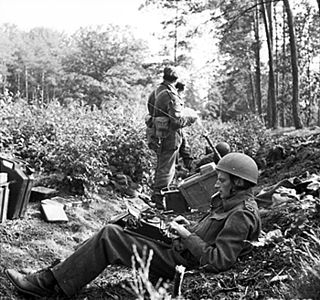
Geraldo Rivera is an American journalist, attorney, author, and political commentator who worked at the Fox News Channel from 2001 to 2023. He hosted the tabloid talk show Geraldo from 1987 to 1998. He gained publicity with the live 1986 TV special The Mystery of Al Capone's Vaults. Rivera hosted the news magazine program Geraldo at Large, hosts the occasional broadcast of Geraldo Rivera Reports. He served as a rotating co-host of The Five from 2022 to 2023.

Peter Gregg Arnett is a New Zealand-born American journalist. He is known for his coverage of the Vietnam War and the Gulf War. He was awarded the 1966 Pulitzer Prize in International Reporting for his work in Vietnam from 1962 to 1965, mostly reporting for the Associated Press.
On April 8, 2003, three locations in Baghdad housing journalists were fired upon by U.S. armed forces during 2003 invasion of Iraq, killing three journalists and wounding four.

The 2003 invasion of Iraq involved unprecedented U.S. media coverage, especially cable news networks.

Patrick Oliver Cockburn is a journalist who has been a Middle East correspondent for the Financial Times since 1979 and, from 1990, The Independent. He has also worked as a correspondent in Moscow and Washington and is a frequent contributor to the London Review of Books.
Anne Longworth Garrels was an American broadcast journalist who worked as a foreign correspondent for National Public Radio, as well as for ABC and NBC, and other media.

Control Room is a 2004 documentary film directed by Jehane Noujaim, about Al Jazeera and its relations with the US Central Command (CENTCOM), as well as the other news organizations that covered the 2003 invasion of Iraq.

A war correspondent is a journalist who covers stories first-hand from a war zone.

Michael Ware is an Australian journalist formerly working in CNN and was for several years based in their Baghdad bureau. He joined CNN in May 2006, after five years with sister publication, Time. His last on-air appearance for the network was in December 2009.

Richard Engel is an American journalist and author who is the chief foreign correspondent for NBC News. He was assigned to that position on April 18, 2008, after serving as the network's Middle East correspondent and Beirut bureau chief. Before joining NBC in May 2003, Engel reported on the start of the 2003 war in Iraq for ABC News as a freelance journalist in Baghdad.
James Brolan was a British freelance journalist and television sound technician, who was killed while working for CBS News in Baghdad, Iraq. Just one month before he was killed in Iraq, Brolan, as part the CBS News team that covered the 2005 Kashmir earthquake, received the 2005 Overseas Press Club Award—the David Kaplan Award for Best Television Spot News Reporting From Abroad.

War Feels Like War is a 2004 British documentary film. Made for BBC Storyville and TV 2 (Denmark), it was broadcast in the United States as part of the P.O.V. series. The film "portrays journalists who covered the war in Iraq without the cover of helmets, bullet-proof vests, or the American military."
James Alan Miklaszewski, known to his colleagues and contacts as "Mik", is a veteran journalist whose career spanned more than forty years, most of it covering the White House and Pentagon for NBC News.
Dana Lewis is a Canadian News Correspondent based in London, and the host of podcast BACK STORY. He is also a reporter appearing on TRT World, LBC Radio. ABC News Australia, and numerous American radio programs.

Christopher John Chivers is an American journalist and author best known for his work with The New York Times and Esquire magazine. He is currently assigned to The New York Times Magazine and the newspaper's Investigations Desk as a long-form writer and investigative reporter. In the summer of 2007, he was named the newspaper's Moscow bureau chief, replacing Steven Lee Myers.

The role of the media in the perception of the Vietnam War has been widely noted. Intense levels of graphic news coverage correlated with dramatic shifts of public opinion regarding the conflict, and there is controversy over what effect journalism had on support or opposition to the war, as well as the decisions that policymakers made in response.

FDD's Long War Journal (LWJ) is an American news website, also described as a blog, which reports on the War on terror. The site is operated by Public Multimedia Incorporated (PMI), a non-profit media organization established in 2007. PMI is run by Paul Hanusz and Bill Roggio. Roggio is the managing editor of the journal and Thomas Joscelyn is senior editor. The site is a project of the Foundation for Defense of Democracies, where both Roggio and Joscelyn are senior fellows.
Nancy A. Youssef is an American journalist currently working as a national security correspondent for the Wall Street Journal. She was previously a national security correspondent for The Daily Beast, Buzzfeed News, and McClatchy Newspapers.
The Persian Gulf War, codenamed Operation Desert Storm and commonly referred to as the Gulf War, was a war waged by a United Nations-authorized coalition force from 34 nations led by the United States against Iraq in response to Iraq's invasion and annexation of Kuwait. Media coverage of the Gulf War was significant for many reasons including CNN's live reporting from a Baghdad hotel, alternative and international coverage, and the use of images.

Jane Ferguson is a journalist from Northern Ireland.













